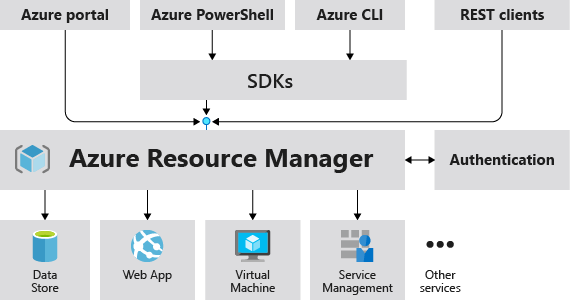ARM is Azure's infrastructure deployment service that takes JSON templates and figures out how to make your infrastructure happen. Every single Azure API call goes through ARM first - it's the bouncer that checks your credentials and decides whether you're allowed to deploy that ridiculously expensive VM you definitely don't need.

The basic idea is simple: write a JSON file describing what you want, throw it at ARM, and pray it doesn't fail with some cryptic error message like "InvalidTemplateDeployment" that tells you absolutely nothing useful.
The JSON Template Hell You're Getting Into
ARM templates are JSON files that define your infrastructure. Sounds simple, right? Wrong. These files grow into thousands of lines of nested curly braces that'll make you question why you didn't just click buttons in the portal like a sane person.
ARM Template Structure Components:
Here's what you're dealing with:
- Resource Groups: Logical containers where you dump related stuff. Delete the group, everything dies. Very handy for nuking test environments that got out of hand.
- Resource Providers: Azure services like
Microsoft.Computethat actually do the work. Each one has its own special way of failing. - Dependencies: ARM tries to figure out what order to deploy things. Sometimes it gets this wrong and your database deploys before the network, which is always fun to debug at 2 AM.
- RBAC: Role-based access control that determines who gets to break what. Essential for enterprise environments where you need to blame someone specific.
Why Bicep Exists (Spoiler: ARM JSON Sucks)
Microsoft created Bicep in 2021 because even they couldn't stand writing ARM templates anymore. Bicep compiles down to the same ARM JSON, but with syntax that won't make you want to quit DevOps. As of September 2025, Bicep v0.37.4 includes an experimental MCP server integration for better VS Code tooling and simplified C# authoring for custom extensions.
The difference is night and day:
- ARM Template: 200 lines of JSON hell for a simple VM
- Bicep: 50 lines that actually make sense to humans
- Dependencies: Bicep figures them out automatically instead of making you declare every single relationship
ARM Template vs Bicep - Side by Side:
// ARM Template (verbose JSON)
{
"type": "Microsoft.Storage/storageAccounts",
"apiVersion": "2019-06-01",
"name": "mystorageaccount",
"location": "[resourceGroup().location]",
"sku": { "name": "Standard_LRS" }
}
// Bicep (clean syntax)
resource mystorageaccount 'Microsoft.Storage/storageAccounts@2019-06-01' = {
name: 'mystorageaccount'
location: resourceGroup().location
sku: { name: 'Standard_LRS' }
}
Migrating from ARM to Bicep is one of the best decisions you can make for your sanity. Trust me, I've been there. The Azure CLI even has a decompile command that converts your existing JSON nightmares to readable Bicep.
The Reality of ARM Deployments
Here's what actually happens when you deploy ARM templates:
- Upload your template and cross your fingers
- ARM validates the template (this can take 5 minutes and still pass validation even if it'll fail deployment)
- ARM starts deploying resources in some order it thinks makes sense
- Something fails with an error message written by someone who hates you
- You spend 3 hours debugging what the error message won't tell you: you don't have permission to deploy B-series VMs
- Repeat until it works or you give up and use the portal
The Azure Activity Log becomes your best friend. It's where you'll find the actual error messages buried six levels deep in JSON that explain why your deployment failed because of a typo in a dependency name.
ARM's Dirty Secrets
Things Microsoft doesn't advertise:
- Template size limits: 4MB max for the template, 64KB for parameters. Hit these limits with complex deployments.
- API throttling: Deploy too much too fast and ARM will rate limit you into next week.
- Deployment timeouts: Some resources take forever to deploy. SQL databases are especially guilty of this.
- Rollback limitations: ARM's rollback isn't magic. It deletes new resources but can't always restore deleted ones.
- What-If limitations: The new Bicep What-If feature (August 2025) can't evaluate expressions like
utcNow()ornewGuid()- they show up as unevaluated placeholders in the preview.
The Azure Resource Manager limits documentation is essential reading. You'll hit these limits eventually, usually at the worst possible time.